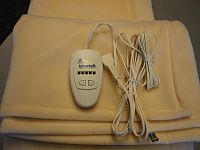
Photo from wikipedia
Traditional conductive fabrics are prepared by the synthesis of conductive polymers and the coating modification of metals or carbon black conductive materials. However, the conductive fabrics cause a significant decline… Click to show full abstract
Traditional conductive fabrics are prepared by the synthesis of conductive polymers and the coating modification of metals or carbon black conductive materials. However, the conductive fabrics cause a significant decline in performance after washing or mechanical wear, which limits their application. Moreover, the single function of the traditional conductive fabric is also the reason that limits its wide application. In order to prepare a wearable, stable, high-performance, washable, multifunctional conductive fabric, we have carried out related research. In this work, polydopamine was used as a bonding layer, an adsorption reduction layer, and a protective layer to improve the bonding between silver nanoparticles and carbon nanotubes (CNTs) on the polyester fabric surface so as to prepare a multifunctional conductive fabric with a high-stability "sandwich" structure, in which a Ag-NPS@CNT structure acting as an intermediate conductive layer formed on the inner layer PDA@CNT by electroless silver plating and the outermost layer PDA@CNT coated on the surface of the intermediate conductive layer by the impregnation-drying method. The sheet resistance of an E-Fabric can reach 2.11 Ω/□ due to the uniform and dense conductive path formed by the special structure Ag-NPs@CNT. At a low voltage of 1.5 V, the E-Fabric can reach 117 °C in 50 s and remain stable. The electrical conductivity and current heating properties of the E-Fabric remain good even after multiple washing or bending tests. Due to its stable and outstanding electrical conductivity, the E-Fabric has an electromagnetic shielding efficiency (SET) of 35.3 dB in the X-band (8.2-12.4 GHz). In addition, E-Fabric-based spin-coated poly(methyl methacrylate) or polydimethylsiloxane electrodes exhibit excellent performance in nanogenerators. Through the low-frequency friction of the human body, transient voltages up to 4 V can be generated from a 2 cm × 2 cm electrode sample. The output power of a single generator can reach about 12 nW/cm2. Therefore, an E-Fabric is considered to have great potential in the fields of electric heating, electromagnetic shielding, and smart wearable devices.
Journal Title: ACS applied materials & interfaces
Year Published: 2023
Link to full text (if available)
Share on Social Media: Sign Up to like & get
recommendations!